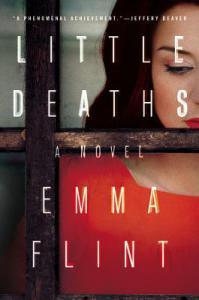
Book Cover Image: Little Deaths by Emma Flint
" data-orig-size="265,400" sizes="(max-width: 199px) 100vw, 199px" aperture="aperture" />BOTTOM LINE: Decent murder mystery but a much better social commentary
Genre: Historical Fiction; Thriller; Crime
Publication Date: 17 January 2017
Source: Publisher
“It’s 1965 in a tight-knit working-class neighborhood in Queens, New York, and Ruth Malone–a single mother who works long hours as a cocktail waitress–wakes to discover her two small children, Frankie Jr. and Cindy, have gone missing. Later that day, Cindy’s body is found in a derelict lot a half mile from her home, strangled. Ten days later, Frankie Jr.’s decomposing body is found. Immediately, all fingers point to Ruth.
As police investigate the murders, the detritus of Ruth’s life is exposed. Seen through the eyes of the cops, the empty bourbon bottles and provocative clothing which litter her apartment, the piles of letters from countless men and Ruth’s little black book of phone numbers, make her a drunk, a loose woman–and therefore a bad mother. The lead detective, a strict Catholic who believes women belong in the home, leaps to the obvious conclusion: facing divorce and a custody battle, Malone took her children’s lives.
Pete Wonicke is a rookie tabloid reporter who finagles an assignment to cover the murders. Determined to make his name in the paper, he begins digging into the case. Pete’s interest in the story develops into an obsession with Ruth, and he comes to believe there’s something more to the woman whom prosecutors, the press, and the public have painted as a promiscuous femme fatale. Did Ruth Malone violently kill her own children, is she a victim of circumstance–or is there something more sinister at play?
Inspired by a true story, Little Deaths, like celebrated novels by Sarah Waters and Megan Abbott, is compelling literary crime fiction that explores the capacity for good and evil in us all.”
My Thoughts: As a murder mystery, Little Deaths is acceptable. The murderer, when finally revealed, is not necessarily a surprise, but Ms. Flint is able to maintain readers’ interest throughout the story by dropping clues that muddy the waters regarding Ruth’s guilt or innocence. Pete’s obsession with Ruth provides an interesting counterstory and adds some depth to what could be a very superficial story.
As a statement about strong women and the issues they face in society, Little Deaths is not just powerful but timely. Perhaps Ms. Flint did not mean for her story to be so timely. Perhaps she did not mean for Ruth’s portrayal and difficulties in life to be the main focus; however given the highly charged gender dynamics occurring in the United States right now, Ruth’s treatment at the hands of her friends and neighbors as well as the police is difficult to ignore and overshadow the murder mystery around which the entire story revolves.
The problem is that Ruth is a strong female who likes sex, who likes her independence, and neither looks or acts like the rest of the women in her neighborhood. The fact that she is a mother of two children only compounds the disconnect. What makes Ruth’s troubles so compelling is the fact that the story occurs in the 1960s and yet female readers today will understand exactly what Ruth faces and the reasons why. Strong women who like sex and their independence are still a threat to certain kinds of men, and there are plenty of females who find them threatening as well. Ruth and Little Deaths is a great reminder that we still have plenty of things that need to change.












Comments
Related Stories
- The Second Mrs. Hockaday is not who you think she is
- The Sleepwalker brings a whole new meaning to sleepwalking
- History is All You Left Me – Teen angst at its finest



